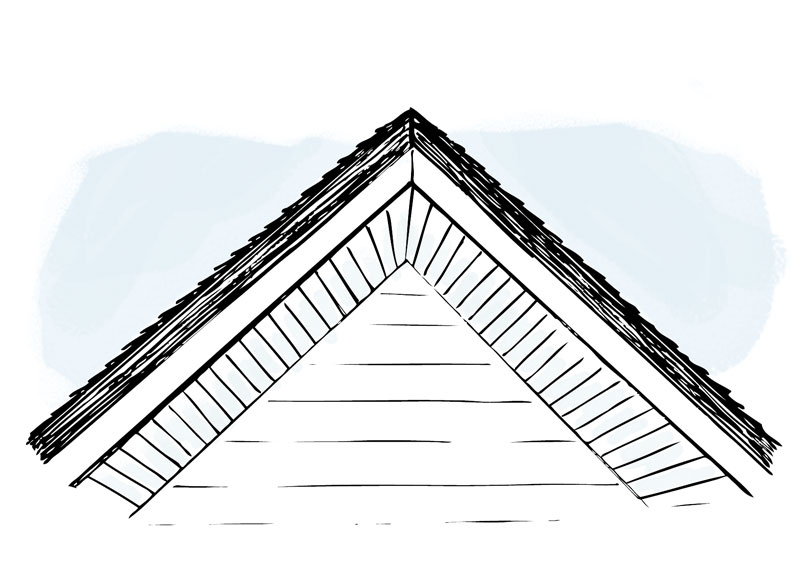
Home Rx
Realtor/science writer/self-proclaimed “house geek” Hannah Holmes on finding a reliable homebuilder, Victorian bathroom habits, and more.
Illustrations by Christine Mitchell Adams
Have a question for Hannah?
Send your Maine home or garden conundrum to hannah@mainehomes.com and we may feature it in an upcoming column.
How do you know when you have to spend the big bucks to repair your ceiling when the plaster looks like it’s starting to peel?
EVE RAIMON, SOUTH PORTLAND

Real, historic, beautiful plaster is a series of layers — layers that can separate. There are many different plaster systems, Peter Lord, of Peter Lord Plaster and Paint in Limington, says. But until about 1920 the most common was wooden laths covered by three grades of plaster, then paint. Typically, if the ceiling is peeling in a flaky manner, you’re seeing just the paint layer come unstuck. A good sanding and priming should resolve that. If it’s peeling in a crazing, geometric manner, you may be seeing the effect of water damage: That can cause the top layer of plaster to detach from the lower layers. If you watch a ton of YouTube videos, you can fix that yourself to a standard that might look ok in candlelight. But water damage and old-house shifting can cause deeper cracks as well. Chipping off the fine surface layer may reveal deep fissures in the gray base layer. Even without chipping, you may be able to flex the plaster with your hand. That means the base layer is detaching from the wooden laths behind. At that point, you either call a professional plaster fixer or have new drywall put in. Neither solution is as expensive as you fear. I’ve had a whole room — plaster walls and ceiling — patched and skim-coated for about $1,000; drywalling a ceiling might be $400 (Portland prices).
How do you protect a home with no eaves?
NAOMI SHERMAN, PALERMO

Armchair architects argue that the crew-cut eaves on a Cape actually are the protection. They claim that a wide and frivolous overhang invites extra snow loading and ice dams, or gives stormy winds unwelcome leverage. Maybe so, but a home with shallow eaves, or none at all, allows rain to course down its siding, potentially seeping inside. This makes it all the more important to install gutters, and monitor the flashing over windows and doors, says building inspector Mike Millett, of 207 Inspect in Raymond. A wide roof also functions to send water away from the foundation. Absent this protection, landscaping and hardscaping around the foundation should be angled to do the job instead. Where landscaping fails, you’ll want to get serious about installing a drainage system that collects and directs water underground. Many Maine basements are damp, with or without a perfect roofing system, so perfection isn’t a reasonable goal. Still, when Millett built his own Cape, he made sure it had wide and frivolous overhangs.
How can I find a reputable homebuilder to remodel an old home in Maine? Especially being an absent owner, I’m wary of being taken advantage of.
KRIS, SAN DIEGO, CALIFORNIA

Some of the best contractors fly under the radar and don’t travel very far, so local networking is often the best way to find them. Real estate agents, home inspectors, and people at the local hardware and flooring store will have suggestions. You might also join the local Nextdoor.com network and seek recommendations there. Once you find a promising candidate, dig deeper. Google may turn up a lawsuit or a news story. Check the name for consumer complaints filed with the Maine Attorney General’s office. Talk to the builder’s most recent clients and ask for photos of the work.
Maine is one of many states that doesn’t license contractors, but the business should carry liability insurance for the contractor and any carpenters. Any plumbing, electrical, and heating subcontractors should carry a current license and insurance. And any job of more than $3,000 requires a written contract, with limits on the amount you pre-pay. For more guidance, visit maine.gov/ag.
Old-house renovations almost always run into complications and cost-creep because nothing is ever level, plumb, or predictable. While there’s no substitute for being on site, great communication, and photographs, go a long way.
How did people handle potty spaces before there was plumbing? There doesn’t seem to be a natural spot for an outhouse at my old house.
SHONNA HUMPHREY, HALLOWELL

Have you checked the cellar? As people packed into cities and town centers in the late 19th century, the backyard privy often retreated into the basement. In fact, older teachers in my ancient grammar school habitually referred to the bathroom as “the basement,” although by my day the loo had long since been promoted to the first floor. If defecating in your cellar seems distasteful, bear in mind that it was customary to do your nighttime business in a casserole dish kept under your bed. Household dung was routinely collected and carted away by “night men.” So maintaining a family-size casserole dish in the basement wouldn’t have been a shocking leap. When flush toilets entered the scene at the turn of the century, many of them were also relegated to the basement, where some remain to this day.
Hannah Holmes is a real estate broker at Keller Williams Realty Greater Portland and the author of four science titles, including The Secret Life of Dust and Suburban Safari. A veteran renovator of old houses, she blogs about humans and their territorial issues at geekrealtyblog.com.





